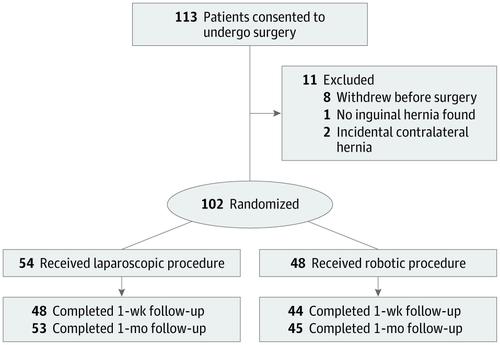JAMA Surgery ( IF 15.7 ) Pub Date : 2020-05-01 , DOI: 10.1001/jamasurg.2020.0034 Ajita S Prabhu 1 , Alfredo Carbonell 2 , William Hope 3 , Jeremy Warren 2 , Rana Higgins 4 , Brian Jacob 5 , Jeffrey Blatnik 6 , Ivy Haskins 1, 7 , Hemasat Alkhatib 1 , Luciano Tastaldi 1, 8 , Aldo Fafaj 1 , Chao Tu 1 , Michael J Rosen 1

|
Importance Despite rapid adoption of the robotic platform for inguinal hernia repair in the US, to date, no level I trials have ever compared robotic inguinal hernia repair to laparoscopic repair. This multicenter randomized clinical trial is the first to compare the robotic platform to laparoscopic approach for minimally invasive inguinal hernia repair.
Objective To determine whether the robotic approach to inguinal hernia repair results in improved postoperative outcomes compared with traditional laparoscopic inguinal hernia repairs.
Design, Setting, and Participants This multicenter, single-blinded, prospective randomized clinical pilot study was conducted from April 2016 to April 2019, with a follow-up duration of 30 days in 6 academic and academic-affiliated sites. Enrolled in this study were 113 patients with a unilateral primary or recurrent inguinal hernia. After exclusions 102 remained for analysis.
Interventions Standard laparoscopic transabdominal preperitoneal repair or robotic transabdominal preperitoneal repair.
Main Outcomes and Measures Main outcomes included postoperative pain, health-related quality of life, mobility, wound morbidity, and cosmesis. Secondary outcomes included cost, surgeon ergonomics, and surgeon mental workload. A primary outcome was not selected because this study was designed as a pilot study. The hypothesis was formulated prior to data collection.
Results A total of 102 patients were included in the study (54 in the laparoscopic group, mean [SD] age, 57.2 [13.3] years and 48 [88.9%] male; 48 in the robotic group, mean [SD] age, 56.1 [14.1] years and 44 [91.6%] male). There were no differences at the preoperative, 1-week, or 30-day points between the groups in terms of wound events, readmissions, pain as measured by the Visual Analog Scale, or quality of life as measured by the 36-Item Short Form Health Survey. Compared with traditional laparoscopic inguinal hernia repair, robotic transabdominal preperitoneal repair was associated with longer median (interquartile range) operative times (75.5 [59.0-93.8] minutes vs 40.5 [29.2-63.8] minutes, respectively; P < .001), higher median (interquartile range) cost ($3258 [$2568-$4118] vs $1421 [$1196-$1930], respectively; P < .001), and higher mean (SD) frustration levels on the NASA Task Load Index Scale (range, 1-100, with lower scores indicating lower cognitive workload) (32.7 [23.5] vs 20.1 [19.2], respectively; P = .004). There were no differences in ergonomics of the surgeons between the groups as measured by the Rapid Upper Limb Assessment instrument.
Conclusions and Relevance Results of this study showed no clinical benefit to the robotic approach to straightforward inguinal hernia repair compared with the laparoscopic approach. The robotic approach incurred higher costs and more operative time compared with the laparoscopic approach, with added surgeon frustration and no ergonomic benefit to surgeons.
Trial Registration ClinicalTrials.gov Identifier: NCT02816658
中文翻译:

机器人腹股沟vs腹腔镜腹股沟疝修补术:RIVAL随机临床试验。
重要性 尽管在美国迅速采用了机器人平台进行腹股沟疝修补,但迄今为止,尚无任何I级试验将机器人腹股沟疝修补与腹腔镜修补相提并论。这项多中心随机临床试验是首次将机器人平台与腹腔镜方法进行微创腹股沟疝修补术进行比较。
目的 确定机器人腹股沟疝修补术与传统腹腔镜腹股沟疝修补术相比是否能改善术后效果。
设计,设置和参与者 这项多中心,单盲,前瞻性随机临床试验研究于2016年4月至2019年4月进行,在6个学术和学术附属站点进行为期30天的随访。这项研究纳入了单侧原发性或复发性腹股沟疝的113例患者。排除之后,保留102用于分析。
干预 标准的腹腔镜腹膜前腹膜修复或机器人经腹腔腹膜前修复。
主要结果和措施 主要结果包括术后疼痛,与健康相关的生活质量,活动能力,伤口发病率和美容。次要结果包括费用,外科医生人体工程学和外科医生的精神工作量。未选择主要结局,因为该研究被设计为试点研究。该假设是在数据收集之前制定的。
结果 共纳入102例患者(腹腔镜组54例,平均[SD]年龄57.2 [13.3]岁,男性48例[88.9%];机器人组48例,平均[SD]年龄56.1岁) [14.1]岁,男44位[91.6%]。两组之间在手术前,1周或30天点的伤口事件,再入院率,通过视觉模拟量表测量的疼痛或通过36项简短表格测量的生活质量方面没有差异健康调查。与传统的腹腔镜腹股沟疝修补术相比,机器人经腹腹膜前腹膜修补术的中位手术时间(四分位间距)更长(分别为75.5 [59.0-93.8]分钟和40.5 [29.2-63.8]分钟;P <.001),较高的中位数(四分位数间距)成本(分别为$ 3258 [$ 2568- $ 4118]与$ 1421 [$ 1196- $ 1930];P <.001),以及NASA任务负荷指数量表的平均(SD)挫败感较高(范围为1-100,得分较低表示认知工作量较低)(分别为32.7 [23.5]和20.1 [19.2];P = .004)。用快速上肢评估仪测量的两组之间,外科医生的人体工程学没有差异。
结论与相关性 这项研究的结果表明,与腹腔镜手术相比,采用机器人方法直接进行腹股沟疝修补术没有临床益处。与腹腔镜手术相比,机器人手术会带来更高的成本和更多的手术时间,给外科医生带来更多的挫败感,并且对外科医生没有人体工程学的好处。
试验注册 ClinicalTrials.gov标识符:NCT02816658









































 京公网安备 11010802027423号
京公网安备 11010802027423号